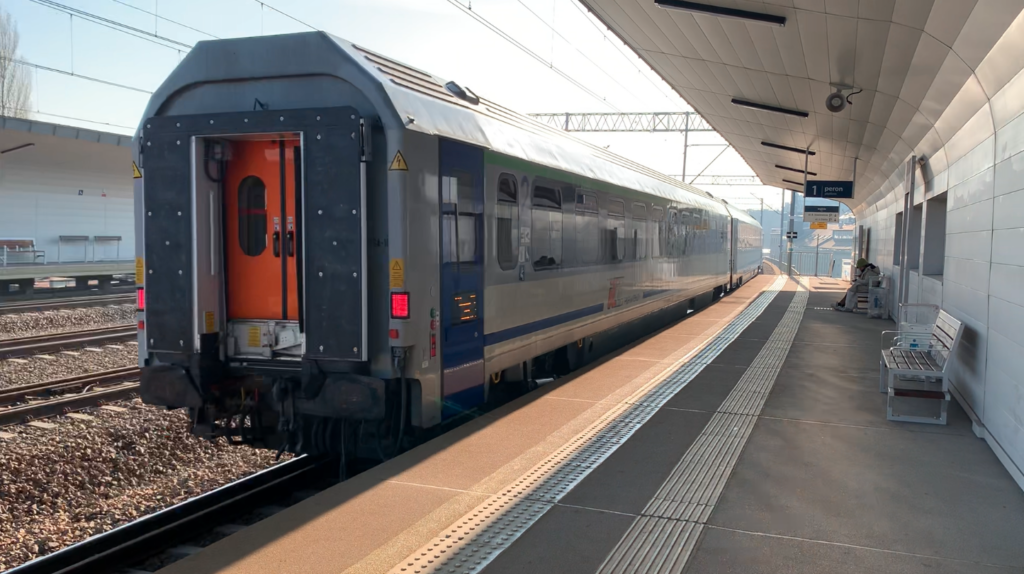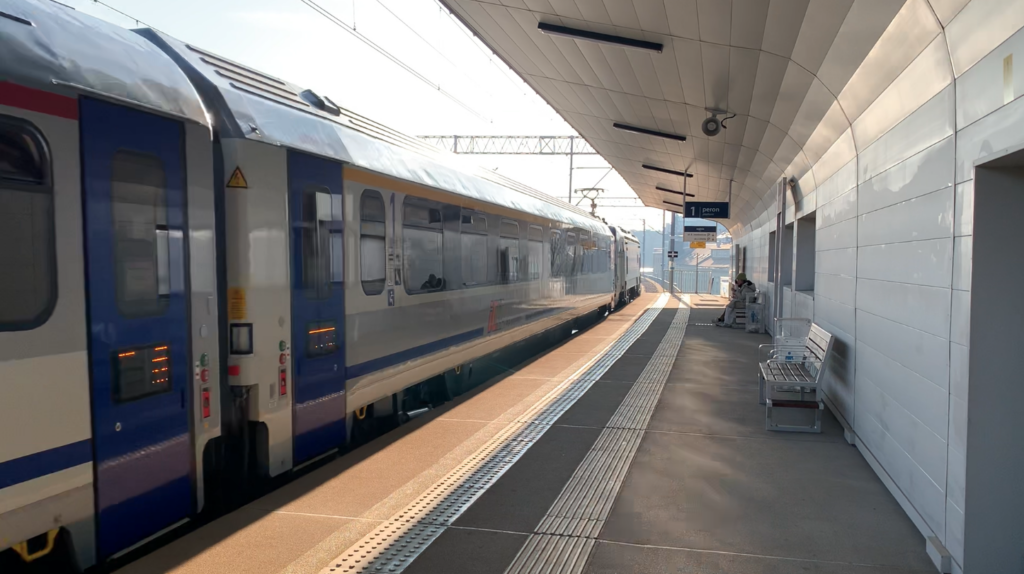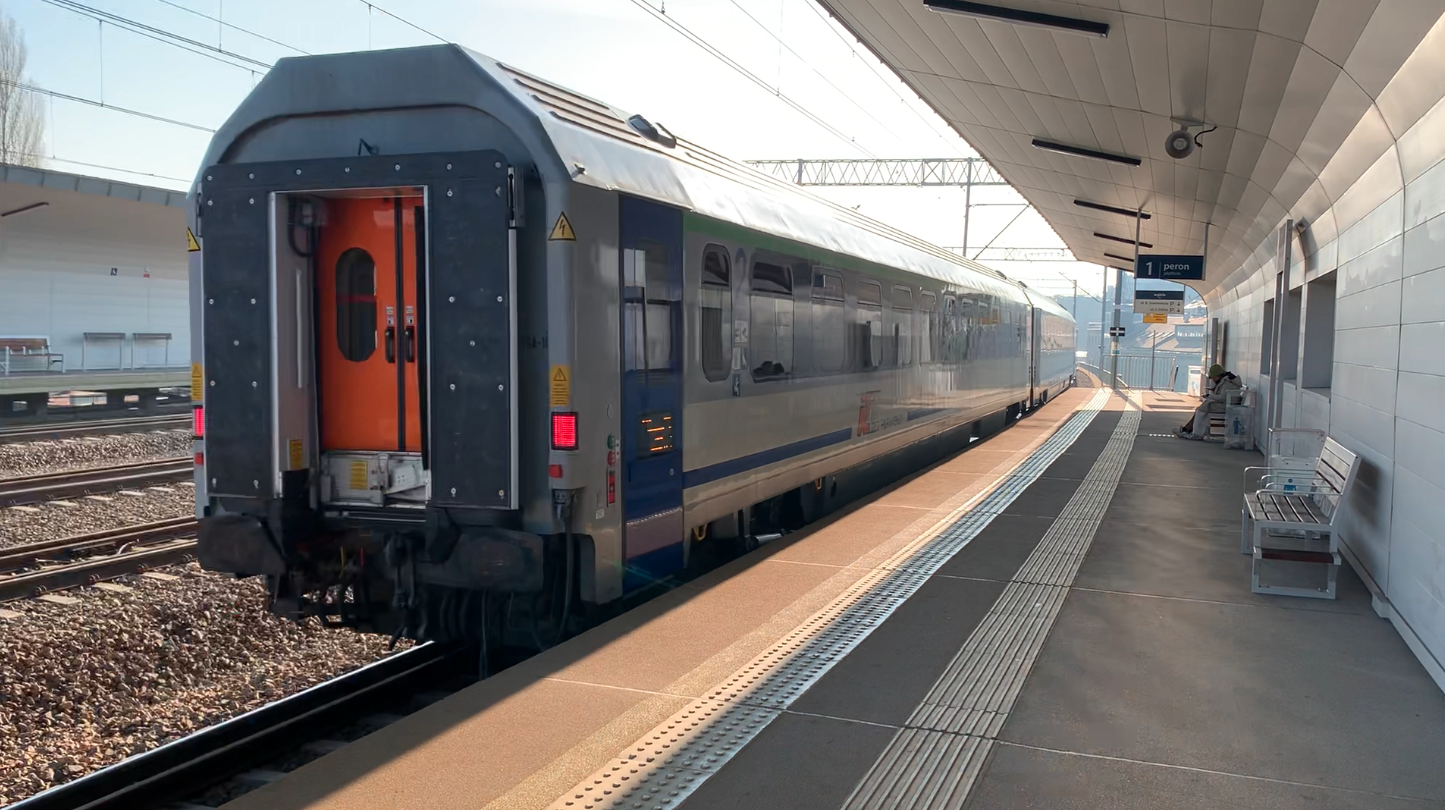Kraków 2024-11-20
Passenger cars of the Rail Vehicle Factory in Poznań for a speed of 200 km/h.


Just a few months ago, a dream was to travel in a traditional wagon train at a speed of 200 km/h. But now (November 2024) this dream has become a reality and more and more InterCity trains with NEWAG EU200 locomotives travel at a speed of 200 km/h, where the routes allow it. Until now, only EZT ED250 “Pendolino” moved at a speed of 200 km/h.
The first locomotive certified for a speed of 200 km/h and delivered to PKP InterCity was the NEWAG EU200-006 locomotive. The entire contract for 15 EU200 locomotives amounts to PLN 388 million. On September 23, 2024, the NEWAG EU200-006 locomotive served the first passenger train of the carrier IC 1510/1 “Słowiniec” on the Warszawa Zachodnia – Gdynia Główna route. On September 26, 2024, the InterCity carrier already had nine EU200 series locomotives. All of these locomotives were already in operation by September 26, 2024. The introduction of EU200 locomotives allowed for the efficient use of modernized rail routes. The fact that the locomotive is multi-system allows the vehicles to be operated abroad.
The current authorities believe that this is the implementation of the High-Speed Rail strategy. But saying that a speed of 160 km/h is high is an exaggeration. However, with the current government (Frenchmen, communists and freemasons), the slogan High-Speed Rail has been blurred. What’s more, this government is destroying the Polish economy so as not to harm the Germans. Let us remember that Germanic lobbying is ongoing for the electrification of Polish rail routes with alternating current.
We must write that in 2024, the PKP InterCity carrier signed contracts for four important rolling stock projects, including two with NEWAG. The first contract for the purchase of 63 multi-system electric locomotives, with an option to order another 32 vehicles and provide a 5-year maintenance service. This is the first such large order for one series of vehicles in the history of both the carrier and the manufacturer. The value of the contract is almost PLN 2.3 billion gross. An order for 46 single-system electric locomotives of the EU160 Griffin series is also underway. The InterCity carrier is seeking to withdraw all used EU07 and EP07 series locomotives. It is worth remembering that NEWAG has been ahead of the locomotive delivery schedule, engaging greater technical resources for their production. It can be said that the production line has been launched.
Locomotives are not everything. After all, there have to be passenger cars. In 2019, FPS (Fabryka Pojazdów Szynowych) delivered 90 modernized 111A cars to InterCity. The order value was PLN 410 million. Then, in November 2020, InterCity received 10 modernized restaurant cars, which were rebuilt from 145Ab type compartment passenger cars. The contract amounted to PLN 61.4 million. In 2021, FPS delivered 8 passenger cars for the Polish Armed Forces, which are being included in echelons. In April 2022, InterCity signed another contract with the factory in Poznań. Its subject is the performance of periodic P5 repairs along with the modernization of 90 111A and 141A type cars. The wagons received new bogies and were approved for a speed of 160 km/h and were classified as Class 2. The value of the entire order amounted to PLN 495 million.
The contract for the new wagons was signed in February 2018, and the first wagon was delivered in December 2021. In 2022, PKP InterCity received the last of 81 wagons, which were manufactured for the carrier by the Poznań-based H. Cegielski – Fabryka Pojazdów Szynowych. Thus, the entire contract, worth nearly PLN 700 million, was completed. All 81 modern wagons are already being used by passengers throughout Poland. The last of them appeared on the tracks at the beginning of January 2023.
At that time (2021), NEWAG was looking for a research entity to test and verify the design solutions of new types of wagon bogies, adapted to a speed of 200 km/h. It was important that the new type of bogie met the European TSI 2022 requirements. NEWAG installed modern 70 RSTb bogies for a speed of 200 km/h. The company from Nowy Sącz started the first work on the new bogie in 2012, but the work was interrupted.
The reader should know that despite analysts’ predictions, classic wagons are in great demand. PKP Intercity was looking for wagons in other countries; Scandinavia, Benelux countries and others. RFI requests for proposals were sent to various European countries. InterCity’s inquiry concerns the possible purchase of: 71 Class 1 compartment or non-compartment air-conditioned wagons. 72 Class 2 compartment air-conditioned wagons. 108 Class 2 non-compartment air-conditioned wagons. 36 Class 2 compartment air-conditioned wagons adapted to transport people with limited mobility. 72 Class 2 non-compartment air-conditioned cars adapted to transport bicycles with at least 8 bicycle hooks. 36 air-conditioned restaurant cars. All cars were to be adapted to a speed of 200 km/h. The cars offered were very expensive and did not meet Polish standards. It was necessary to modernize Polish passenger cars, even 40 years old. Therefore, cooperation between NEWAG and FPS turned out to be natural. PESA in Bydgoszcz was also planning to produce passenger cars.
There must be passenger cars with a speed of 200 km/h. In August 2024, PKP InterCity and H. Cegielski – Fabryka Pojazdów Szynowych signed a contract for the delivery of 300 new cars. This order may be increased under the option right, by another 150 vehicles. The value of the contract is PLN 4.2 billion gross. The cars have been designed to a completely new standard and will be able to run at a speed of 200 km/h, meaning they will be cars for EU200 locomotives. According to plans, by the end of 2030, InterCity may have 715 traditional cars for a speed of 200 km/h.
The new carriages meet higher requirements. The interiors are more cosy and comfortable, with atmospheric LED lighting. 230 V sockets, 5 V USB, mobile signal amplifiers and a WiFi system are mandatory. Air conditioning and a passenger information system also ensure a comfortable journey. The carriages have a monitoring system (mainly against vandals) and a fire detection system. Class 1 and Class 2 carriages have additional space for luggage and more comfortable seats. A big change is the space intended for parents travelling with children, with a safe space for them to play. When it comes to passenger seats, we must know that their ergonomics are dictated by the regulations of the European collective farm, which are not always logical.
The issue of entering wheelchairs into the carriage is controversial. Until now, manually foldable ramps were used in passenger carriages. Similarly to public transport buses. Whether elevators will be built in is a debatable issue. Let us remember that additional mechanisms require more attention and care. In addition, for many years, PKP has had an assistant for people requiring support, who can easily unfold the ramp. On the other hand, there is plenty of space in the vestibules and there is no problem maneuvering a wheelchair or bringing in large luggage.
The 81 carriages delivered to PKP InterCity include: 7 Class 1 compartment carriages. 27 Class 2 non-compartment carriages. 27 Class 2 compartment carriages. 10 Class 2 non-compartment carriages with spaces for transporting bicycles (each equipped with 8 bicycle hangers). 10 Class 2 compartment carriages adapted to transport people with disabilities.
The delivery of 81 passenger carriages was a new quality in InterCity. These carriages are adapted to a travel speed of 200 km/h. Among these carriages were 10 Class 2 compartment carriages, adapted to transport people with disabilities. These wagons have been awarded the prestigious “Transport without barriers” certificate, granted by the Integracja Foundation. Receiving the mark confirms that they are adapted to the needs of people with disabilities, seniors or parents traveling with children. Previously, COMBO wagons received such certification.
These wagons were manufactured in accordance with the Technical Specifications for Interoperability, which enable efficient and effective movement on the trans-European rail network, although a certificate from a given country must be obtained.
FPS Wagon, 2nd Class, B9mnopuvz 175A-10.
FPS Wagon, 2nd Class, B9mnopuvz 175A-10, non-compartment, has 72 seats, seats 11, 13, 15, 17, 84, 86, 95, 97 are designed for disabled people, space for 2 bicycles, air conditioning, 230 V sockets, WiFi. Half of the seats are set in one direction, the other in the opposite direction. The seats have an upholstered seat in navy blue and an orange accent at the headrest with the InterCity logo. The rest is kept in gray colors. Each seat has armrests and in the backrest has a table and a hanger, for the passenger sitting in the back. In the middle of the length of the car and at both ends of the row of seats, there are large tables. In the car, from the inside, a different shape of the roof is visible, which is now higher. Four monitors with train information are mounted under the ceiling. The monitors display the train route, toilet availability and more. There are also surveillance cameras installed for the safety of passengers and to prevent vandals. The walls, floor and ceiling are in shades of grey. The windows are equipped with sun and darkening blinds. Shelves for hand luggage are placed along the carriage, above the windows. At the entrance to the single-space compartment, shelves for large luggage and bicycle racks are mounted on both sides. All doors in the carriage open automatically using a button, and then close by themselves. A screen with information about the train route and the carriage number is placed on the entrance door. The same information is repeated in the entrance vestibule. The entrance doors are navy blue, which was a requirement of the European collective farm. There is also a plate with the carriage inventory number and type symbol (for example: PL-PKPIC 61 51 29-91 014-2 B9mnopuz). There is a fire extinguisher in the vestibule. The B9mnopuvz 175A-10 cars received new roofs, grooved, new front walls with new train tail lights and completely new protection of the inter-car passage. The corners have been rounded more. This is a Z standard car, i.e. it has a length of 26.40 m.
FPS Wagon, 2nd Class, B11mnouz 176A-10.
FPS Wagon, 2nd Class, B11mnouz 176A-10, compartment (11 compartments with 6 seats each), 66 seats, air conditioning, 230 V sockets, 5V USB, WiFi. The first and last compartment is intended for disabled people and people with small children. All seats have armrests. The upholstery is navy blue with an orange headrest element, where the InterCity logo is placed. Mirrors are placed above the seats and above them there are luggage racks. The corridor from the entrance vestibule is separated by swing doors. All toilets are in a closed system. Water is supplied automatically to the toilet bowl and to the sink. The bowl is additionally disinfected. Control is by buttons, just like the entrance door. This is a Z standard carriage, i.e. it is 26.40 m long.
FPS Wagon, 2nd Class, B9bmnopuz 177A-10.
FPS carriage, 2nd Class, B9bmnopuz 177A-10, compartment, air conditioning, 230 V sockets, WiFi. The carriage is adapted to transport disabled people, seats 81-86 or 91-96 for the conductor’s team; seats 11, 12 for disabled people in wheelchairs; seats 15, 16 for disabled carers. The carriage has a large toilet where you can enter a wheelchair. The compartment for disabled people is very large and has four seats. The doors to this compartment are automatically activated by a button. This is a Z standard carriage, i.e. it is 26.40 m long.
FPS Wagon, 1st Class, A9mnouz 178A-10.
FPS Wagon, 1st Class, A9mnouz 178A-10, compartment (9), 54 seats, air conditioning, 230 V sockets, 5V USB, WiFi. The seats can slide longitudinally, which changes the angle of the backrest. The upholstery is blue, with a navy blue element on the headrest with the InterCity logo. The difference between the B9bmnopuz 177A-10 and the A9mnouz 178A-10 is a much larger amount of space in the compartment and the proximity of the BAR car. This is a standard Z car, i.e. it is 26.40 m long.
Opracował Karol Placha Hetman

Leave a Reply
You must be logged in to post a comment.